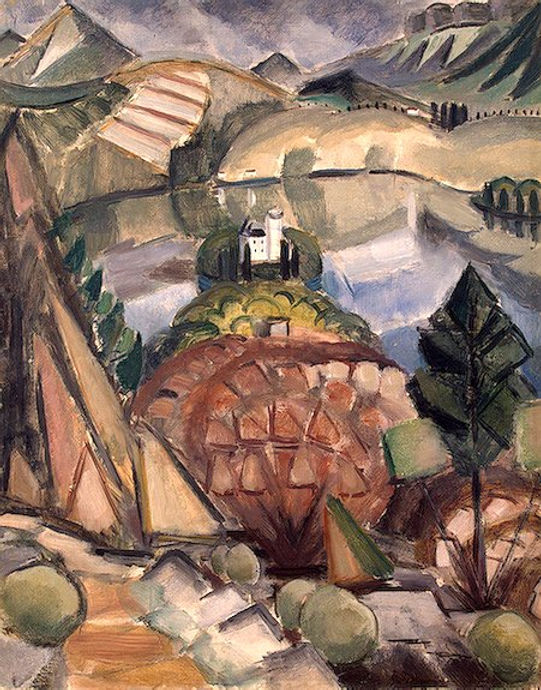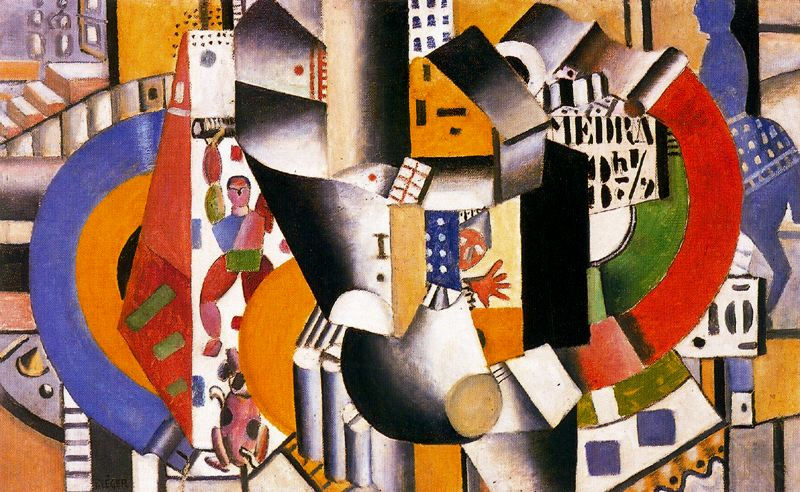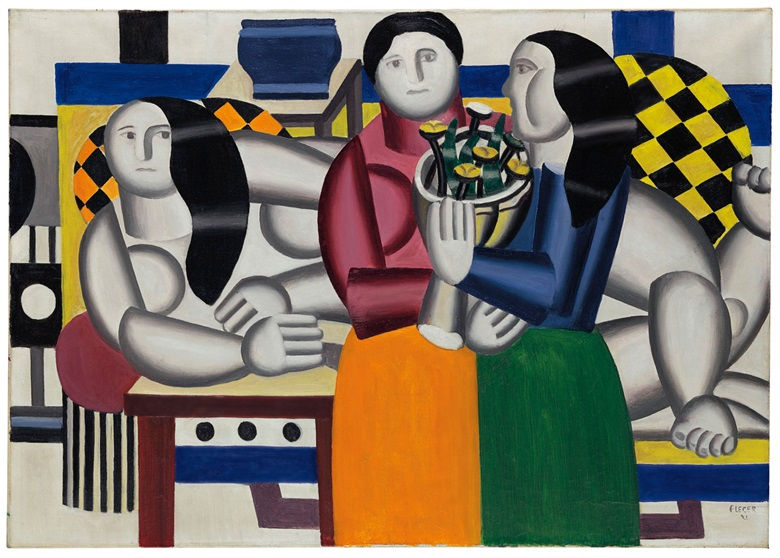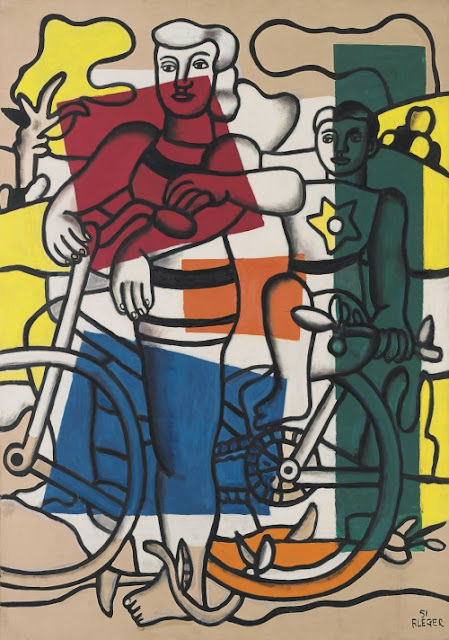
Cubism - I
Henri Le Fauconnier 1881 – 1946
Albert Gleizes 1881 – 1953
Fernand Leger 1881 – 1955
Cubism
Cubism is an early-20th-century art movement which brought European painting and sculpture historically forward toward 20th century Modern art. Cubism in its various forms inspired related movements in music, literature and architecture. Cubism has been considered to be among the most influential art movements of the 20th century. The term is broadly used in association with a wide variety of art produced in Paris (Montmartre, Montparnasse and Puteaux) during the 1910s and extending through the 1920s.
The movement was pioneered by Georges Braque and Pablo Picasso, joined by Andre Lhote, Jean Metzinger, Albert Gleizes, Robert Delaunay, Henri Le Fauconnier, Fernand Léger and Juan Gris. One primary influence that led to Cubism was the representation of three-dimensional form in the late works of Paul Cézanne. A retrospective of Cézanne's paintings had been held at the Salon d'Automne of 1904, current works were displayed at the 1905 and 1906 Salon d'Automne, followed by two commemorative retrospectives after his death in 1907. In Cubist artwork, objects are analyzed, broken up and reassembled in an abstracted form—instead of depicting objects from a single viewpoint, the artist depicts the subject from a multitude of viewpoints to represent the subject in a greater context.
The impact of Cubism was far-reaching and wide-ranging. In other countries Futurism, Suprematism, Dada, Constructivism, De Stijl and Art Deco developed in response to Cubism. Early Futurist paintings hold in common with Cubism the fusing of the past and the present, the representation of different views of the subject pictured at the same time, also called multiple perspective, simultaneity or multiplicity, while Constructivism was influenced by Picasso's technique of constructing sculpture from separate elements. Other common threads between these disparate movements include the faceting or simplification of geometric forms, and the association of mechanization and modern life.
Historians have divided the history of Cubism into phases. In one scheme, the first phase of Cubism, known as Analytic Cubism, a phrase coined by Juan Gris a posteriori, was both radical and influential as a short but highly significant art movement between 1910 and 1912 in France. A second phase, Synthetic Cubism, remained vital until around 1919, when the Surrealist movement gained popularity. English art historian Douglas Cooper proposed another scheme, describing three phases of Cubism in his book, The Cubist Epoch. According to Cooper there was "Early Cubism", (from 1906 to 1908) when the movement was initially developed in the studios of Picasso and Braque; the second phase being called "High Cubism", (from 1909 to 1914) during which time Juan Gris emerged as an important exponent (after 1911); and finally Cooper referred to "Late Cubism" (from 1914 to 1921) as the last phase of Cubism as a radical avant-garde movement. Douglas Cooper's restrictive use of these terms to distinguish the work of Braque, Picasso, Gris (from 1911) and Léger (to a lesser extent) implied an intentional value judgement.
Cubism began between 1907 and 1911. Pablo Picasso's 1907 painting Les Demoiselles d'Avignon has often been considered a proto-Cubist work. Georges Braque's 1908 Houses at L’Estaque (and related works) prompted the critic Louis Vauxcelles to refer to bizarreries cubiques (cubic oddities). Gertrude Stein referred to landscapes made by Picasso in 1909, such as Reservoir at Horta de Ebro, as the first Cubist paintings. The first organized group exhibition by Cubists took place at the Salon des Indépendants in Paris during the spring of 1911 in a room called 'Salle 41'; it included works by Jean Metzinger, Albert Gleizes, Fernand Léger, Robert Delaunay and Henri Le Fauconnier, yet no works by Picasso or Braque were exhibited.
Henri Le Fauconnier
1881 – 1946

Henri Le Fauconnier
Henri Victor Gabriel Le Fauconnier (July 5, 1881 – December 25, 1946) was a French Cubist painter born in Hesdin. Le Fauconnier was seen as one of the leading figures among the Montparnasse Cubists. At the 1911 Salon des Indépendants Le Fauconnier and colleagues Jean Metzinger, Albert Gleizes, Fernand Léger and Robert Delaunay caused a scandal with their Cubist paintings. He was in contacts with many European avant-garde artists such as Wassily Kandinsky, writing a theoretical text for the catalogue of the Neue Künstlervereinigung in Munich, of which he became a member. His paintings were exhibited in Moscow reproduced as examples of the latest art in Der Blaue Reiter Almanach (The Blue Rider Almanac).
Portrait of Henri Le Fauconnier by Jan Toorop, 1918

Henri Le Fauconnier, L'Abondance (Abundance), 1910-11

Henri Le Fauconnier, 1911-12, Le Chasseur (The Huntsman)

Lake.Henri Le Fauconnier1911

Mountaineers Attacked by Bears
Henri Le Fauconnier
1912

Figures
Henri Le Fauconnier
1913

MODELE A LA GUITARE
Henri Le Fauconnier

Vielle Femme
Henri Le Fauconnier

Interior With A Guitar
Henri Le Fauconnier

The Signal
Henri Le Fauconnier
1915

Little Schoolgirl
Henri Le Fauconnier
1907
Albert Gleizes
1881 – 1953

Albert Gleizes
8 December 1881 – 23 June 1953) was a French artist, theoretician, philosopher, a self-proclaimed founder of Cubism and an influence on the School of Paris. Albert Gleizes and Jean Metzinger wrote the first major treatise on Cubism, Du "Cubisme", 1912. Gleizes was a founding member of the Section d'Or group of artists. He was also a member of Der Sturm, and his many theoretical writings were originally most appreciated in Germany, where especially at the Bauhaus his ideas were given thoughtful consideration. Gleizes spent four crucial years in New York, and played an important role in making America aware of modern art. He was a member of the Society of Independent Artists, founder of the Ernest-Renan Association, and both a founder and participant in the Abbaye de Créteil. Gleizes exhibited regularly at Léonce Rosenberg's Galerie de l’Effort Moderne in Paris; he was also a founder, organizer and director of Abstraction-Création. From the mid-1920s to the late 1930s much of his energy went into writing, e.g., La Peinture et ses lois (Paris, 1923), Vers une conscience plastique: La Forme et l’histoire (Paris, 1932) and Homocentrisme (Sablons, 1937).

Albert Gleizes, 1910, La Femme aux Phlox (Woman with Phlox)

Albert Gleizes, 1911, Portrait de Jacques Nayral

Albert Gleizes, 1912, Les Baigneuses (The Bathers)

Albert Gleizes, 1912–13, Les Joueurs de football (Football Players)

Albert Gleizes, 1913, L'Homme au Hamac (Man in a Hammock)

Albert Gleizes, 1911, La Chasse (The Hunt)

Albert Gleizes, Woman and child (Femme et enfant, Frau und Kind), Der Sturm, 5 October 1921
Fernand Leger
1881 —1955

FERNAND LEGER:
COMPOSITION WITH THREE FIGURES. 1932.

Leger Fernand
(1881 —1955). French painter, trained initially as an architectural designer. He studied in various Paris studios between 1903 and 1907 when, like many others, he discovered Cezanne. For the next 7 years, reacting against the diffuseness of his early Neo-Impressionist manner, he worked towards a concentrated structural strength in his painting. His early *Cubist paintings (nicknamed 'tubist') differed from the mainstream m their volumetric solidity, in their deep space and in a *Futurist 'tendency towards the dynamic'. With his friend Delannay he was one of the most influential Cubist painters: Mondrian greatly admired him and the transitional works (c. 1911—12) of Malevich seem to derive directly from paintings such as Nus dans un paysage (1909—11). By 1912 (La Femme en Bleu) he was Hearing abstraction. He attributed his post-war abandonment of his path to his wartime discoveries first of the working man and second or the beauty of machinery. His major works are of contemporary subjects, simple in their black contours and bold colour areas and endowing the ordinary man with a 19th-c. monumentality, e.g. Les Loisins (1948—9). His contact with *De Stijl circles in the 1930s did not diminish his deep respect for the figurative tradition. He also collaborated on a film, Le Ballet mecaniqtie (1923—4) with Man Ray, and designed for stained glass, mosaics, ceramics and the stage.

FERNAND LEGER:
El circo
1918

FERNAND LEGER:
Woman with a Cat
1921

FERNAND LEGER:
Las dos mujeres y el bodegon
1920

FERNAND LEGER:
Les trois femmes au bouquet, 1922.

FERNAND LEGER:
La mujer y el niño (1922)

FERNAND LEGER:
Three Women. 1921

FERNAND LEGER:
Woman with a Book
1923

FERNAND LEGER:
Mona Lisa with the keys
1930

FERNAND LÉGER:
SPARE-TIME ACTIVITIES -HOMAGE TO LOUIS DAVID. 1948-1949. Paris. MNAM

FERNAND LEGER:
ÉTUDE POUR LES PLONGEURS, 1942

FERNAND LEGER:
Les grands Plongeurs noirs, 1944

FERNAND LEGER:
Le Disque Rouge, 1943

FERNAND LEGER:
Starfish
1942

FERNAND LEGER:
La gran Julie
1945

FERNAND LEGER:
FAREWELL, NEW YORK. 1946. Paris

FERNAND LEGER:
Les deux cyclistes, la mère et l'enfant (1951)

FERNAND LEGER:
Le campeur, The camper. 1954

FERNAND LEGER:
The Great Parade. 1954.